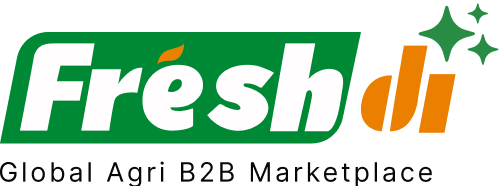Introduction – Thailand’s Soybean Market in Statistical Focus
Thailand’s soybean market paints a vivid picture of contrast—low domestic production on one hand, and booming demand and imports on the other. Despite ranking 63rd globally in soybean production with a negligible 0.00% market share, Thailand is the fifth-largest importer of soybeans, commanding a 2.22% share of global imports. In 2024 alone, the Thai soybean market was valued at $2.1 billion, underscoring its strategic relevance in Asia’s agribusiness sphere.
Yet, it’s not all smooth sailing. Flooding in 2024 wiped out over 8.6 million rai of farmland, and the country’s crushing capacity is growing at a sluggish 2% annually, far below pre-pandemic levels. This is where data-driven supplier selection becomes critical. For businesses aiming to source soybeans or soybean oil in Thailand, understanding market dynamics and identifying top-performing suppliers isn’t just smart—it’s necessary.
Platforms like Freshdi play a pivotal role here, offering verified supplier data, RFQ trends, and dynamic rankings to help buyers make informed sourcing decisions.
Deep Dive – Key Production, Export Statistics & Market Signals
Production Realities
Thailand’s domestic soybean production is modest, hovering around 50,000 to 60,000 metric tons annually. Why so low? Mainly because farmers prefer cultivating higher-margin crops like cassava and corn. Another major hurdle is the government’s ban on genetically modified soybean cultivation, keeping yields low and production expansion limited.
The Import Machine
To meet domestic demand, Thailand depends heavily on imports—around 3.9 million metric tons in 2022-23, with projections nearing 4 million metric tons for 2023-24. Brazil and the United States are the primary exporters to Thailand. Interestingly, this demand isn’t just for food. About 70% of these imports are crushed into cooking oil, while the rest go into animal feed and processed foods.
Export Snapshot
Thailand doesn’t export much raw soybean. In 2023, exports were merely 299,229 kg, valued at just $294,380. Most of this went to nearby markets like Lao PDR, Cambodia, China, and Singapore.
Consumption Patterns and Demand Signals
The Thai Feed Mill Association expects a 5% increase in total feed demand in 2023, with swine feed demand alone jumping 15%. This surge is tied to the recovery of hotels, restaurants, and the catering sector post-COVID. Freshdi’s RFQ data also shows a spike in demand for soybean meal and oil, especially from buyers in the animal feed and food manufacturing industries.
Top 4 Verified Soybean Suppliers in Thailand – Week 24, 2025
After analyzing export data, buyer reviews, and certifications on Freshdi, here are the top 4 verified soybean suppliers in Thailand for Week 24 of 2025:
1. F D & A Inter Co. Ltd.
- Specializes in: Soybean oil (refined and crude)
- Strength: Consistently ranks high on export performance metrics
- Certifications: ISO certified, HACCP compliant
- Markets Served: Vietnam, India, and UAE
2. E-POR IMPORT & EXPORT CO., LTD
- Specializes in: Refined soybean oil and crude degummed soybean oil
- Strength: Competitive pricing and strong logistics network
- Certifications: GMP, FDA registered
- Markets Served: Myanmar, Bangladesh, and Malaysia
3. TREVEX INTER COMPANY LIMITED
- Specializes in: Premium refined soybean oil
- Strength: High buyer satisfaction and repeat purchases
- Certifications: Halal, ISO 22000
- Markets Served: Middle East, Africa, and South America
4. J.C.P IMPORT AND EXPORT CO., LTD
- Specializes in: Non-GMO refined soybean oil
- Strength: Transparent sourcing and traceability
- Certifications: Non-GMO Project Verified, HACCP
- Markets Served: Japan, South Korea, and Australia
Dynamic Ranking Note: Supplier rankings on platforms like Freshdi may change weekly based on real-time export volumes, buyer feedback, and RFQ activity. Keep an eye on their “Suppliers of the Month” feature for the latest updates.
Market Navigation – Statistical Trends, Value Dynamics & Export Dynamics
Demand Trends: Who’s Buying and Why
In 2024, Thailand’s animal feed demand hit 21.8 million tons, up from 21.1 million the previous year. About 60% of the feed components—including soybean meal—are imported. The livestock sector, especially poultry and swine, remains the largest consumer, making up a whopping 900 billion baht of the national economy. That’s a lot of mouths to feed—literally.
Freshdi’s RFQ data shows a growing trend of bulk orders from feed manufacturers and food processors looking for refined soybean oil and soybean meal. These signals align with the broader macroeconomic recovery in hospitality and food services.
Seasonal Price Fluctuations: Timing is Everything
Soybean prices in Thailand follow seasonal and global patterns. In 2024, a combination of excellent harvests in Brazil and the U.S. pushed global prices down by 15.5%. For savvy buyers, this presents an opportunity for cost-effective bulk purchases.
Want to stay ahead of the curve? Use historical pricing data and Freshdi’s market insights dashboard to time your procurement right. Think of it like booking flights—buy early when prices dip, and you’ll get the best deal.
Export Dynamics: A Downward Slide
Thailand’s soybean exports have been on the decline for five consecutive years. In 2024, exports dipped again, with Lao PDR and Cambodia remaining the top destinations. This shrinkage is likely due to increasing domestic demand and reduced production capacity.
Conclusion – Leveraging Data for Strategic Sourcing
Thailand’s soybean market is a tale of trade-offs. On one hand, there’s limited domestic production and declining exports. On the other, there’s surging demand for imports and processed soybean products like oil and meal. Whether you’re sourcing for food manufacturing, animal feed, or retail, data is your best friend.
Platforms like Freshdi empower businesses by aggregating trade data, supplier performance metrics, and market trends. You don’t have to guess who the top suppliers are—they’re ranked based on real-world performance.
Checklist for Buyers: Sourcing Soybeans in Thailand
✅ Look for suppliers with verified export data and certifications
✅ Use Freshdi to track weekly RFQ trends and supplier performance
✅ Time your purchases around seasonal price dips
✅ Prioritize suppliers with strong logistics and global reach
✅ Keep updated on Thai import policies and global price forecasts
Future Outlook: What’s Next for Thailand’s Soybean Market?
- Continued Import Growth: Expect Thailand to import over 4 million metric tons of soybeans annually through 2026.
- Soybean Oil Boom: With biofuel mandates and food industry demand rising, soybean oil production is on an upward trajectory.
- Supplier Diversification: Businesses will seek diversified sourcing strategies to offset global supply risks.
- Tech-Driven Procurement: Platforms like Freshdi will become central to strategic sourcing, thanks to real-time data and supplier analytics.
FAQs
1. Why is Thailand such a big importer of soybeans if it produces them domestically?
Because domestic production is low due to poor yields, government restrictions on GM crops, and farmer preferences for more profitable crops like cassava and corn.
2. What percentage of Thailand’s soybean imports are used for cooking oil?
Roughly 70% of imported soybeans are crushed into cooking oil, with the rest used for animal feed and processed foods.
3. How can I find the best soybean suppliers in Thailand?
Check out Freshdi—they rank suppliers based on export data, buyer feedback, and RFQ volumes.
4. Are soybean prices in Thailand stable year-round?
Not really. Prices fluctuate seasonally and are influenced by global harvests, trade policies, and domestic demand. Timing your purchase is key.
5. Is it better to import soybean oil or raw soybeans into Thailand?
Depends on your operation. For food and retail, refined oil may be more convenient. For feed mills, raw soybeans or meal might be better. Either way, let data guide your choice.
References
- IndexBox – Thailand Soybean Market Report
- World-Grain – Thailand Soybean Imports
- USDA Export Sales Report
- Freshdi – Top Soybean Suppliers Week 22 2025
- Fitch Solutions – Soybean Market Forecast
- WITS – World Bank Trade Data
- ADMIS – Global Ag News Feb 2025
- AgFlow – Thailand Opens Soybean Market
- USSEC – Asia Soy Food Report
- Tridge – Soybean Production in Thailand


